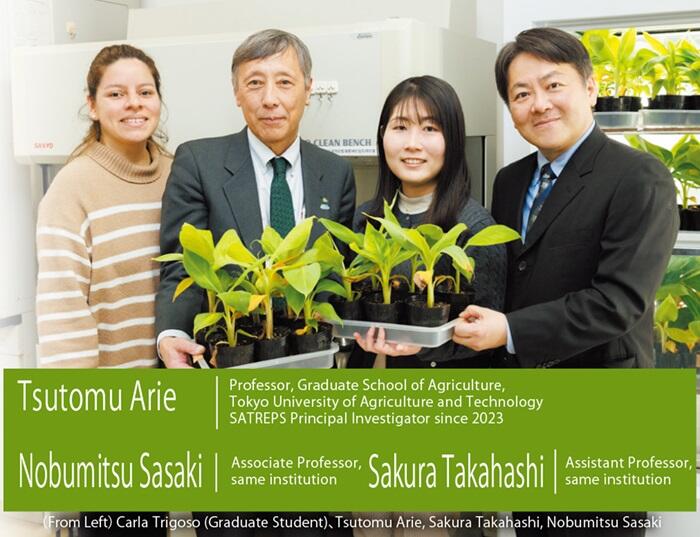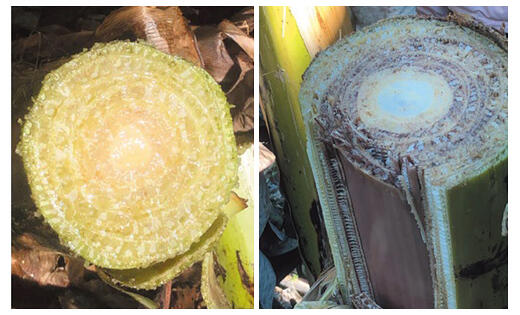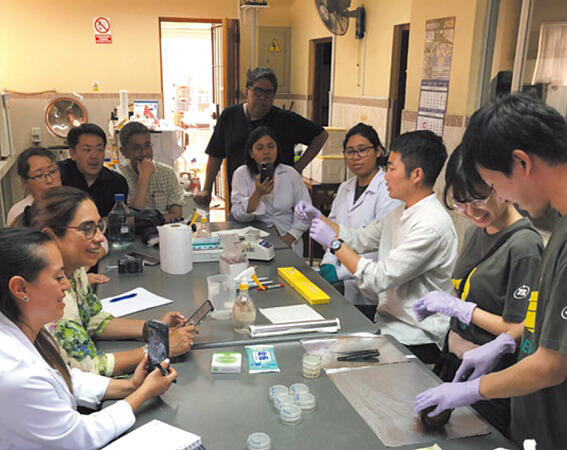In the segment 'A Look Around Innovation,' we introduce research and development (R&D) sites that have led to social implementation. In the 20th installment of this series, we introduce Professor Tsutomu Arie of the Department of Bioregulatory Science, Graduate School of Agriculture, at Tokyo University of Agriculture and Technology, who is developing specific diagnostic methods and strategies to prevent infection and damage caused by Fusarium fungi, the pathogen causing Fusarium wilt, a major disease of bananas. He aims to disseminate detection technology in Peru, South America.

The threat of highly pathogenic new Fusarium wilt pathogens: Seeking to improve living standards of local residents
At the Fuchu Campus of Tokyo University of Agriculture and Technology, there is a vast expanse of farmland that seems unimaginable for a university in Tokyo. What Professor Tsutomu Arie showed us in his laboratory were lush green banana seedlings. However, the bananas we commonly eat are now facing a crisis from infectious diseases. Arie began by saying, "The culprit is Fusarium wilt." The pathogen is a member of the Fusarium fungi family, commonly known as "mold," which lurks in soil, enters through the plant's roots, and spreads to its above-ground parts through the vascular bundle. Eventually, the stem cracks, leaves turn yellow, and finally the plant withers and dies (Figure 1).
Many plants are susceptible to Fusarium wilt caused by fungi. Arie's team have been conducting research into how tomato Fusarium wilt pathogens acquired pathogenicity in tomatoes. For this reason, they were conducting field surveys of Fusarium fungi in the Andes, including Peru, which is where tomatoes originally came from. During this work, they recognized that the pandemic of the new banana Fusarium wilt pathogen "TR4" was also approaching Peru, leading them to begin collaborative research.
In the 1950s, banana Fusarium wilt infections spread throughout Central and South America, making it impossible to cultivate Gros Michel, the major banana variety at the time, leading to the collapse of production areas and enormous damage. Subsequently, Cavendish bananas, which are less susceptible to Fusarium wilt, became the mainstay of the world's commercial banana trade. However, in the 1990s, damage from TR4 began occurring in Southeast Asian regions such as the Philippines and Malaysia. It has now spread to Australia, Africa, and the South American continent, and there are concerns about infection spreading in Peru as well.
To confront this threat, Arie applied and was selected for JST's SATREPS program in collaboration with Tottori University, the Japan International Research Center for Agricultural Sciences, RIKEN, and universities and research institutions in Peru. This project aims to establish and disseminate diagnostic and control measures for Fusarium wilt in Peru's inland Selva region, the Amazon jungle area. While TR4 has not yet invaded this region, if infections spread to the bananas used as a staple food, it would directly impact residents' lives. There are also social issues of low resident income, and the goal is to enhance the value of banana production in the region through innovation and even improve residents' living standards.

LAMP method enables measurement in a short time — Spanish language manual also prepared
Meanwhile, Associate Professor Nobumitsu Sasaki and Assistant Professor Sakura Takahashi are conducting research to breed bananas resistant to TR4 by irradiating them with heavy ion beams to induce mutations. Additionally, Fusarium wilt pathogens do not exist in the shoot apex, the part of the banana where cell division is active. Therefore, they also aim to disseminate a system in Peru for tissue culture based on shoot apices, proliferating healthy seedlings free from the pathogen infection and distributing them to farmers.
Essential to these experiments is the detection of Fusarium wilt pathogens (both conventional and new types), which are invisible to the naked eye, in plant tissues and soil. It is necessary to detect the fungi in all aspects of the research - whether bananas are infected with the pathogen and whether the fungi exist in the soil in the first place. When it comes to pathogen detection, there is the PCR method, which became famous during the COVID-19 pandemic. However, this method has the disadvantage of requiring specialized equipment due to repeated three-stage temperature changes during measurement and takes several hours to obtain results.
Therefore, Arie's team focused on the LAMP method. The LAMP method uses six types of DNA fragment called primers designed based on the target gene sequence, utilizing strand displacement to amplify the target DNA. With this method, diagnosis is possible at a constant temperature of approximately 60 degrees Celsius, with results available in about one hour. Arie emphasized that "the LAMP method explosively increases DNA, so the presence or absence of genes specific to Fusarium wilt pathogens can be determined in a short time. The required equipment is also simple," making it a method easily usable for diagnosis even in the Selva region where facilities are not well-equipped (Figure 2).
While the LAMP method itself is an established technology, research for its use in diagnosing Fusarium wilt pathogens was not smooth at all. Due to its high sensitivity, samples without the pathogen sometimes tested positive. He recalls that students sometimes failed when demonstrating at academic events. "But students grow through experiencing such failures," Arie said. Subsequently, they succeeded in detecting the pathogen using the LAMP method, and a primer set was commercialized by Nippon Gene Co., Ltd. (Chiyoda City, Tokyo Prefecture), a company that develops reagents. The SATREPS website publishes manuals for testing methods, and there are also Spanish-language manuals available for use in Peru.

Active student exchange and human resource development - Agriculture starts in the field
Arie and his team regularly visit Peru with students, conducting diagnostic demonstrations for local students, researchers, and personnel who guide farmers, thus engaging in human resource development. On these occasions, students often take the lead in explanations (Figure 3). "Things you think you understand in your head often don't go well when you try to explain them to others. Attempting to explain by yourself advances understanding of the research."
Sasaki noted, "Although our culture and lifestyle differ from those in Peru, we hold online meetings once every two weeks, so we can understand each other well. On top of this, direct dialogue is important." Takahashi also emphasized the importance of visiting the site, saying, "Even though it's difficult to understand cultivation and culture conditions through screens, we can grasp them by going to the site, and the research direction becomes clear." Personnel exchange is also active, with Peruvian exchange student Carla currently enrolled in the laboratory, and conversely, students from Arie's laboratory have also stayed in Peru for extended periods.
"Agriculture starts in the field." Arie believes that his work is to understand what problems are occurring in the field, how to perceive those challenges, and how to return solutions to the field. We hope that Arie's research will lead to saving Peru's—and the world's—banana industry.

(Article: Shosuke Shimada, Photography: Erika Shimamoto)




